1998 CADILLAC SEVILLE phone
[x] Cancel search: phonePage 79 of 378
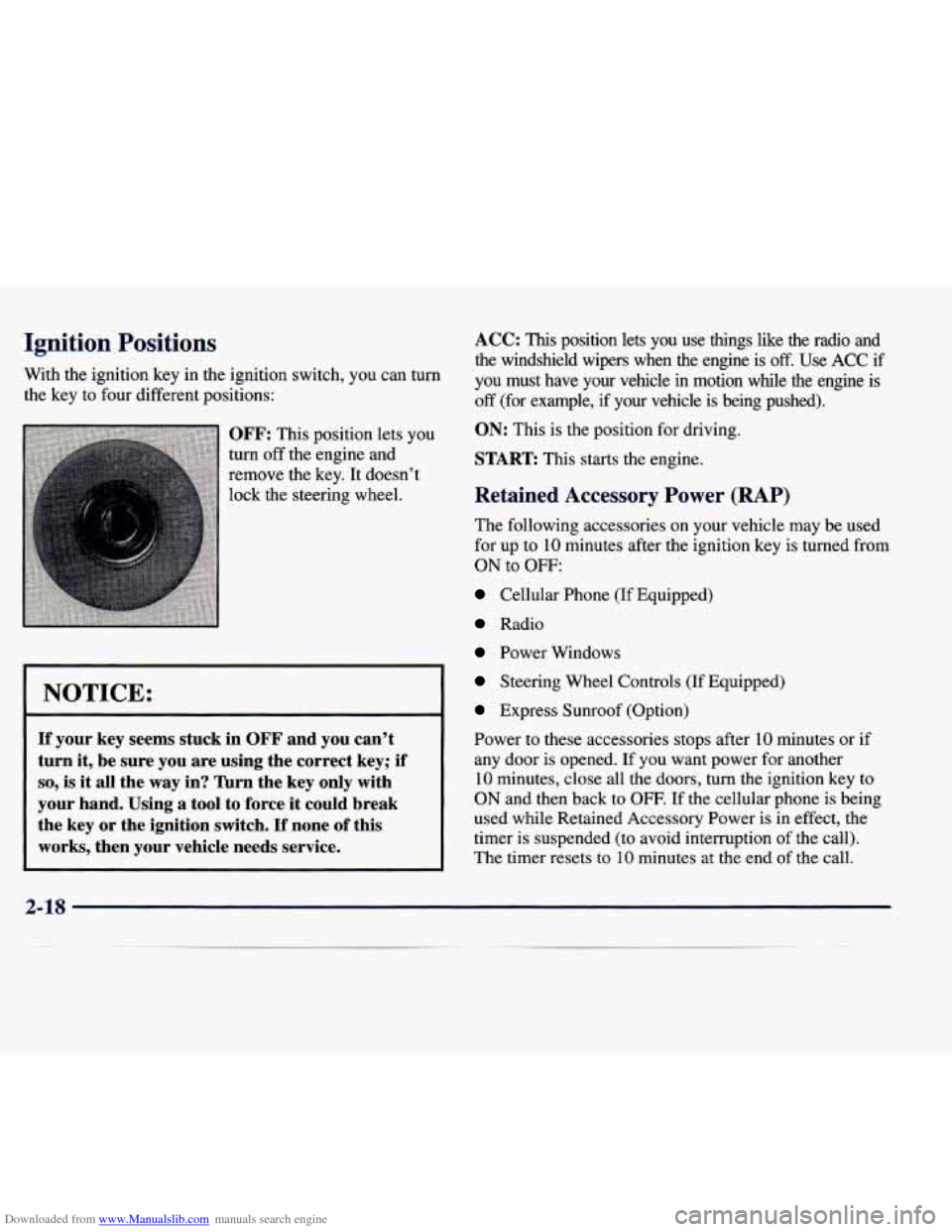
Downloaded from www.Manualslib.com manuals search engine Ignition Positions
With the ignition key in the ignition switch, you can turn
the key to four different positions:
OFF: This position lets you
turn
off the engine and
remove the key. It doesn’t
lock the steering wheel.
NOTICE:
If your key seems stuck in OFF and you can’t
turn it, be sure you are using the correct key; if
so, is it all the way in? Turn the key only with
your hand. Using a tool to force it could break
the key
or the ignition switch. If none of this
works, then your vehicle needs service.
- ~
ACC: This position lets you use things like the radio and
the windshield wipers when the engine is
off. Use ACC if
you must have your vehicle in motion while
the engine is
off (for example, if your vehicle is being pushed).
ON: This is the position for driving.
START This starts the engine.
Retained Accessory Power (RAP)
The following accessories on your vehicle may be used
for up to
10 minutes after the ignition key is turned from
ON to OFF:
Cellular Phone (If Equipped)
Radio
Power Windows
Steering Wheel Controls (If Equipped)
Express Sunroof (Option)
Power to these accessories stops after
10 minutes or if
any door is opened. If you want power for another
10 minutes, close all the doors, turn the ignition key to
ON and then back to OFF. If the cellular phone is being
used while Retained Accessory Power is in effect, the
timer is suspended (to avoid interruption of the call).
The timer resets to
10 minutes at the end of the call.
2-18
Page 113 of 378
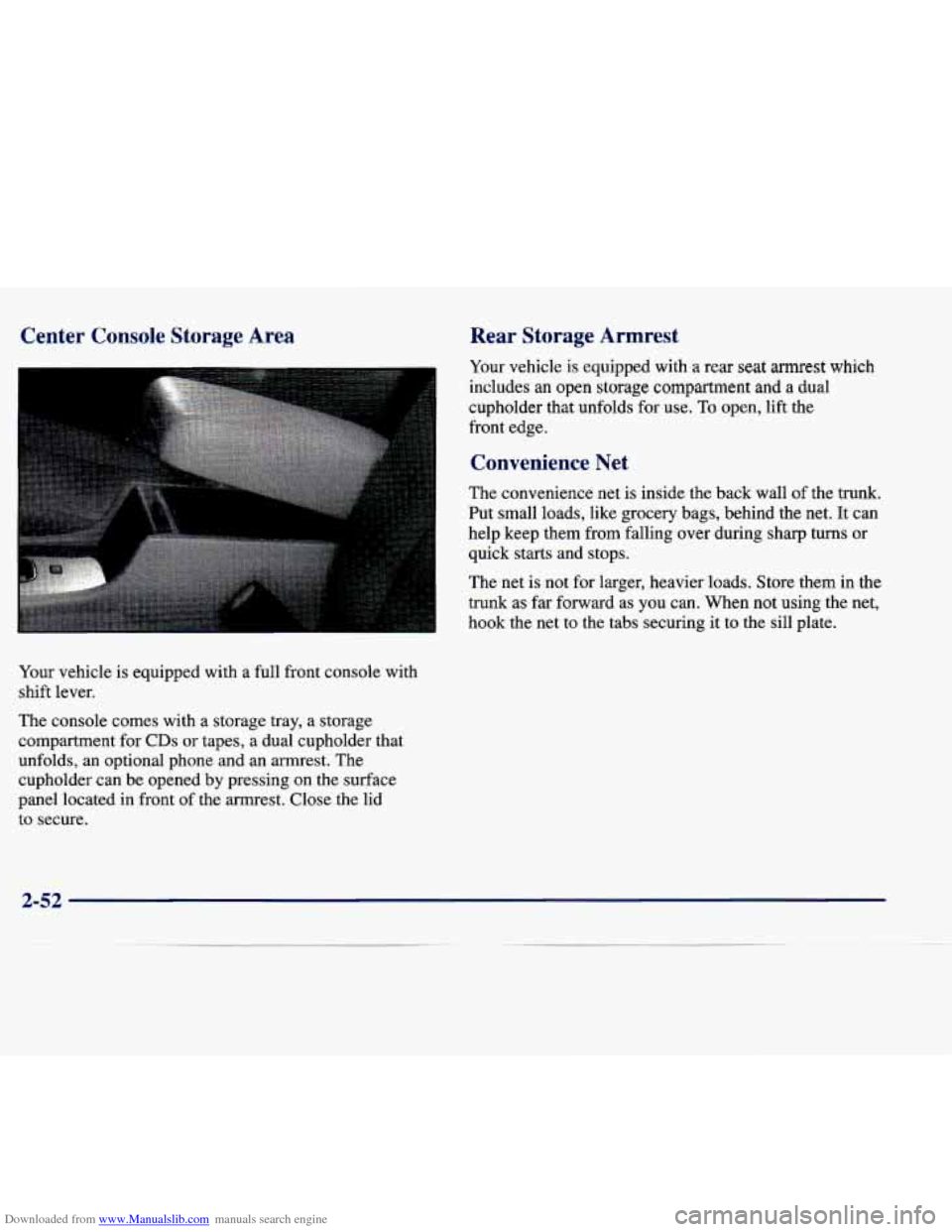
Downloaded from www.Manualslib.com manuals search engine Center Console Storage Area Rear Storage Armrest
Your vehicle is equipped with a rear seat armrest which
includes an open storage compartment and a dual
cupholder that unfolds for use.
To open, lift the
front edge.
Convenience Net
The convenience net is inside the back wall of the trunk.
Put small loads, like grocery bags, behind the net.
It can
help keep them from falling over during sharp turns
or
quick starts and stops.
The
net is not for larger, heavier loads. Store them in the
trunk
as far forward as you can. When not using the net,
hook the net to the tabs securing it
to the sill plate.
Your vehicle is equipped with a full front console with
shift lever.
The console comes with a storage tray, a storage
compartment for
CDs or tapes, a dual cupholder that
unfolds, an optional phone and an armrest. The
cupholder can be opened
by pressing on the surface
panel located in front of the armrest. Close the lid
to secure.
2-52
Page 115 of 378
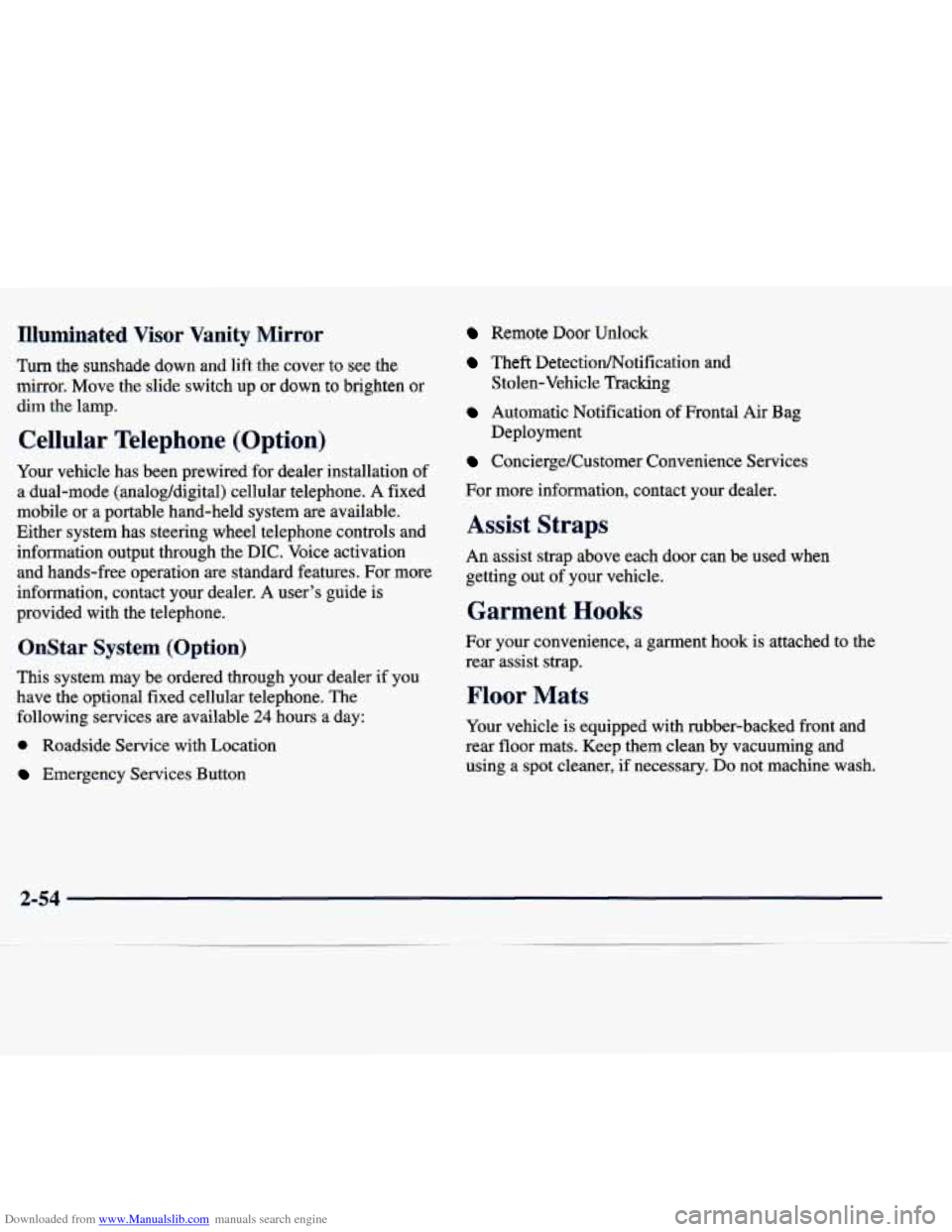
Downloaded from www.Manualslib.com manuals search engine Illuminated Visor Vanity Mirror
Turn the sunshade down and lift the cover to see the
mirror. Move the slide switch up or down to brighten or
dim the lamp.
Cellular TeleI '>one (Option)
Remote Door unlock
Your vehicle has been prewlred for dealer installation of
a dual-mode (analog/digital) cellular telephone. A fixed
mobile or a portable hand-held system are available.
Either system has steering wheel telephone controls and information output through the DIC. Voice activation
and hands-free operation are standard features. For more
information, contact your dealer.
A user's guide is
provided with the telephone.
OnStar System (Option)
This system may be ordered through your dealer if you have the optional fixed cellular telephone. The
following services are available
24 hours a day:
0 Roadside Service with Location
Emergency Services Button
Theft DetectiodNotification and
Stolen-Vehicle Tracking
Deployment
Automatic Notification of Frontal Air Bag
Concierge/Customer Convenience Services
For more information, contact your dealer.
Assist Straps
An assist strap above each door can be used when
getting out of your vehicle.
Garment Hooks
For your convenience, a garment hook is attached to the
rear assist strap.
Floor Mats
Your vehicle is equipped with rubber-backed front and
rear floor mats. Keep them clean by vacuuming and using a spot cleaner,
if necessary. Do not machine wash.
2-54
Page 142 of 378
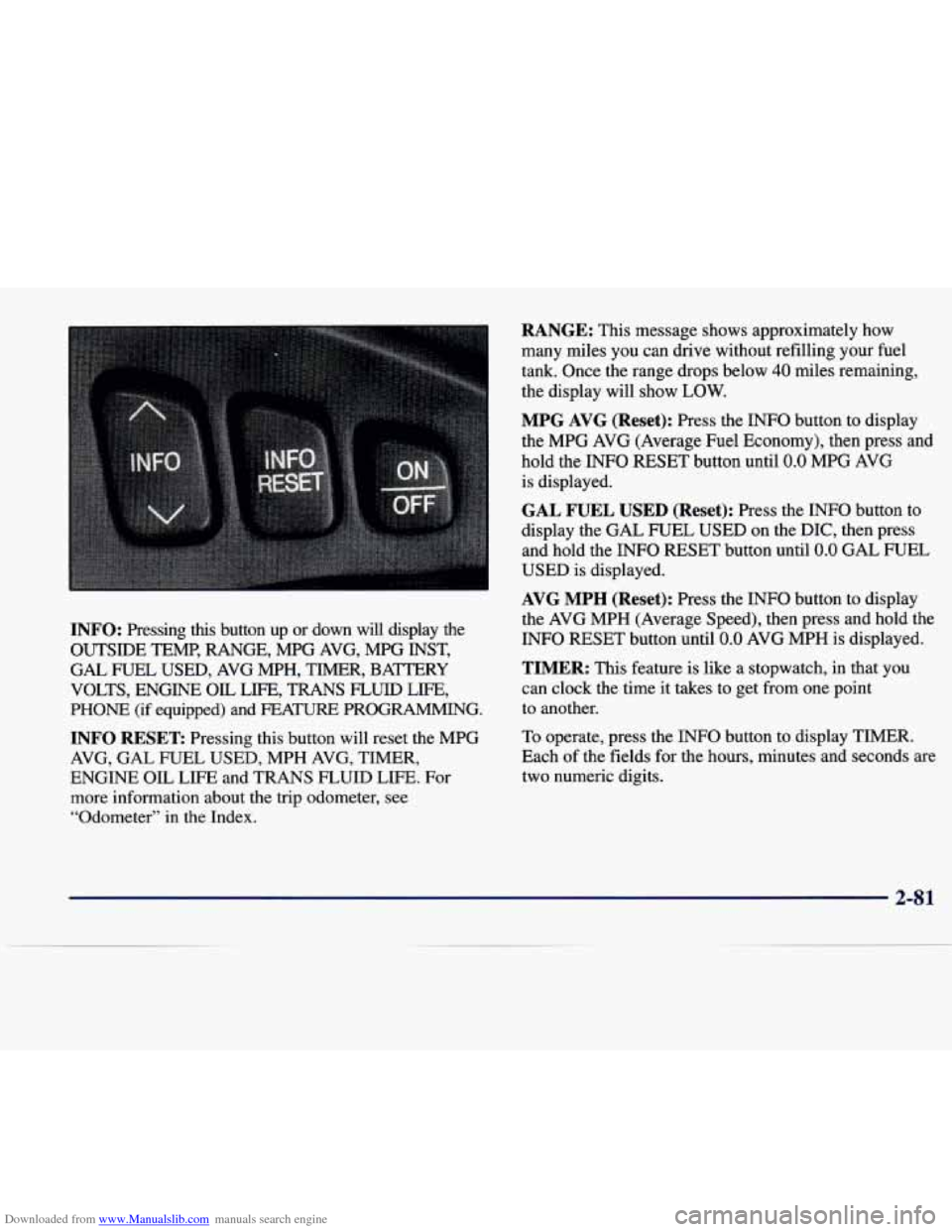
Downloaded from www.Manualslib.com manuals search engine INFO: Pressing this button up or down will display the
OUTSIDE TEMP, RANGE, MPG AVG, MPG INST,
GAL FUEL USED, AVG MPH, TIMER, BAmRY
VOLTS, ENGINE
OIL LIFE, TRANS FLUID LIFE,
PHONE (if equipped) and FEA- PROGRAMMING.
INFO RESET Pressing this button will reset the MPG
AVG, GAL FUEL USED, MPH AVG, TIMER,
ENGINE OIL LIFE and TRANS FLUID LIFE. For
more information about the trip odometer, see
“Odometer”
in the Index.
RANGE: This message shows approximately how
many miles you can drive without refilling your fuel
tank. Once the range drops below
40 miles remaining,
the display will show
LOW.
MPG AVG (Reset): Press the INFO button to display
the MPG AVG (Average Fuel Economy), then press and
hold the INFO RESET button until
0.0 MPG AVG
is displayed.
GAL FUEL USED (Reset): Press the INFO button to
display the GAL FUEL USED on the DIC, then press
and hold the INFO RESET button until
0.0 GAL FUEL
USED is displayed.
AVG MPH (Reset): Press the INFO button to display
the AVG MPH (Average Speed), then press and hold the
INFO RESET button until
0.0 AVG MPH is displayed.
TIMER: This feature is like a stopwatch, in that you
can clock the time it takes to get from one point
to another.
To operate, press the
INFO button to display TIMER.
Each
of the fields for the hours, minutes and seconds are
two numeric digits.
2-8 1
Page 194 of 378
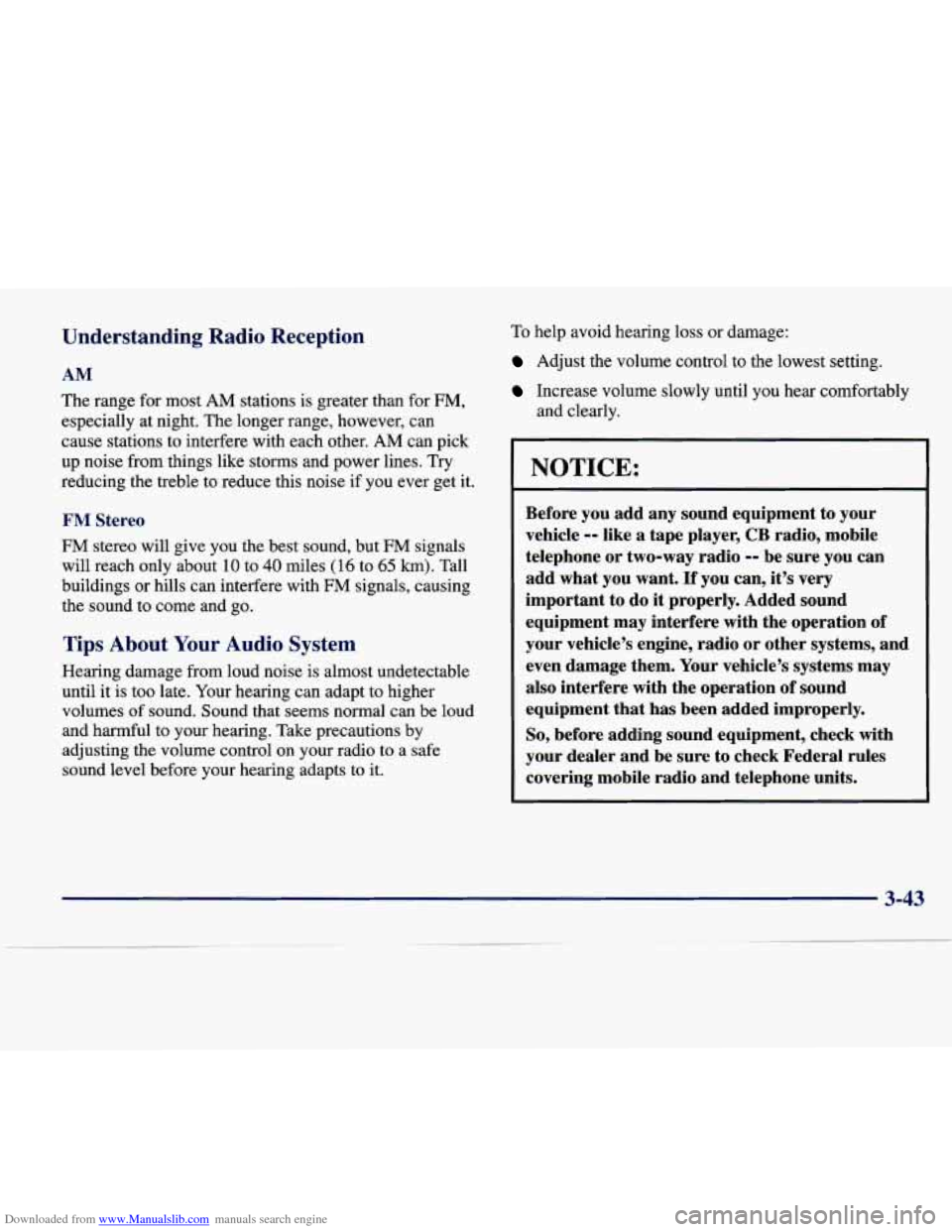
Downloaded from www.Manualslib.com manuals search engine Understanding Radio Reception
AM
The range for most AM stations is greater than for FM,
especially at night. The longer range, however, can
cause stations to interfere with each other. AM can pick
up noise from things like storms and power lines. Try
reducing the treble to reduce this noise if you ever get it.
FM Stereo
FM stereo will give you the best sound, but FM signals
will reach only about
10 to 40 miles ( 16 to 65 km). Tall
buildings or hills can interfere with
FM signals, causing
the sound to come and go.
Tips About Your Audio System
Hearing damage from loud noise is almost undetectable
until it is too late. Your hearing can adapt to higher
volumes
of sound. Sound that seems normal can be loud
and harmful to your hearing. Take precautions by
adjusting the volume control on your radio to a safe
sound level before your hearing adapts to it.
To help avoid hearing loss or damage:
Adjust the volume control to the lowest setting.
Increase volume slowly until you hear comfortably
and clearly.
NOTICE:
Before you add any sound equipment to your
vehicle
0- like a tape player, CB radio, mobile
telephone or two-way radio
-0 be sure you can
add what you want.
If you can, it’s very
important
to do it properly. Added sound
equipment may interfere with the operation
of
your vehicle’s engine, radio or other systems, and
even damage them. Your vehicle’s systems may
also interfere with the operation
of sound
equipment that has been added improperly.
So, before adding sound equipment, check with
your dealer and be sure to check Federal rules
covering mobile radio and telephone units.
3-43
Page 196 of 378
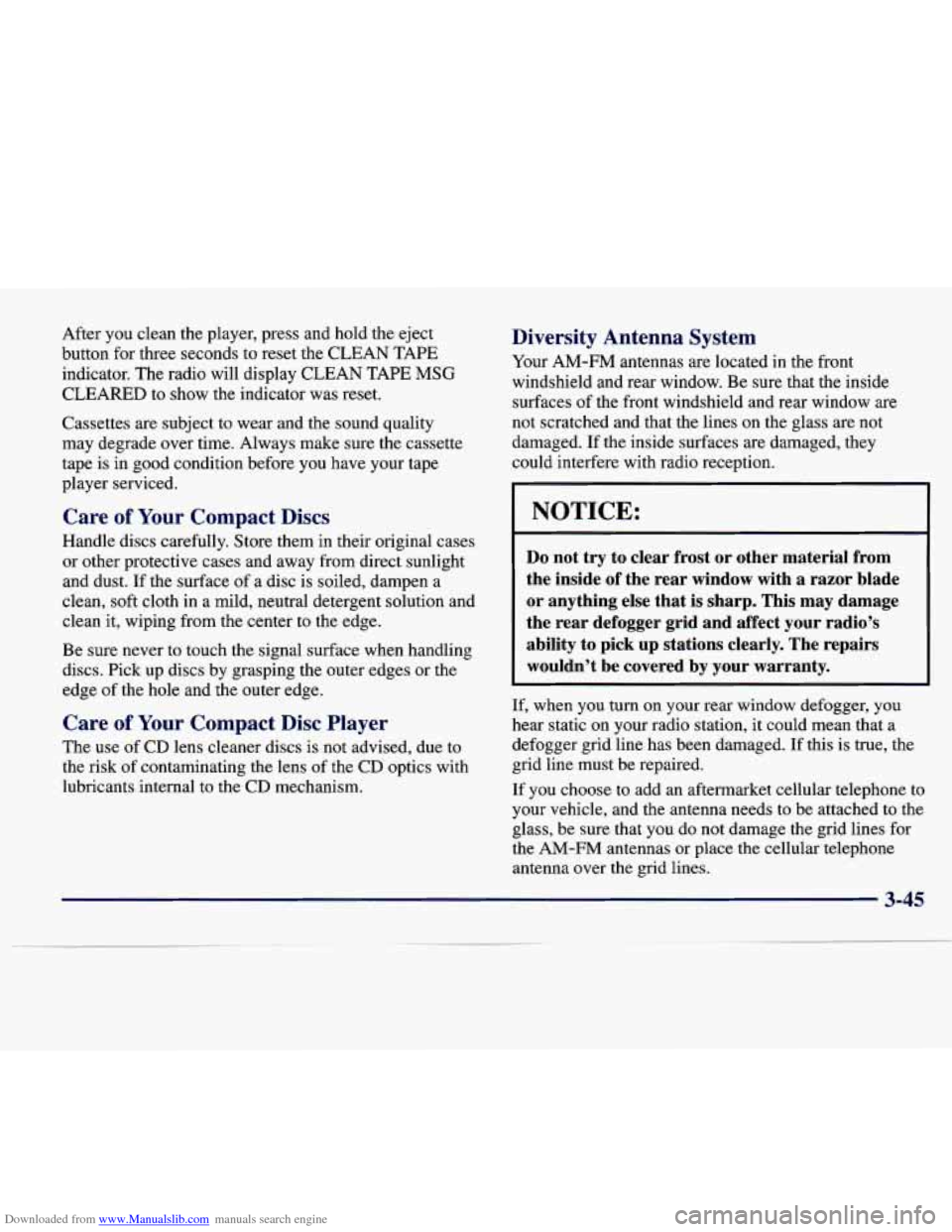
Downloaded from www.Manualslib.com manuals search engine After you clean the player, press and hold the eject
button for three seconds to reset the CLEAN TAPE
indicator. The radio will display CLEAN TAPE MSG
CLEARED to show the indicator was reset.
Cassettes are subject to wear and the sound quality
may degrade over time. Always make sure the cassette
tape is in good condition before you have your tape
player serviced.
Care of Your Compact Discs
Handle discs carefully. Store them in their original cases
or other protective cases and away from direct sunlight
and dust. If the surface of a disc is soiled, dampen a
clean, soft cloth in
a mild, neutral detergent solution and
clean it, wiping from the center to the edge.
Be sure never to touch the signal surface when handling discs. Pick up discs by grasping the outer edges or the
edge
of the hole and the outer edge.
Care of Your Compact Disc Player
The use of CD lens cleaner discs is not advised, due to
the risk
of contaminating the lens of the CD optics with
lubricants internal to the CD mechanism.
Diversity Antenna System
Your AM-FM antennas are located in the front
windshield and rear window. Be sure that the inside
surfaces of the front windshield and rear window are
not scratched and that the lines on the glass are not
damaged.
If the inside surfaces are damaged, they
could interfere with radio reception.
NOTICE:
Do not try to clear frost or other material from
the inside of the rear window with a razor blade
or anything else that
is sharp. This may damage
the rear defogger grid and affect your radio’s
ability
to pick up stations clearly. The repairs
wouldn’t be covered by your warranty.
If, when you turn on your rear window defogger, you
hear static on your radio station, it could mean that a
defogger grid line has been damaged. If this is true, the
grid line must be repaired.
If you choose to add an aftermarket cellular telephone to
your vehicle, and the antenna needs to be attached to
the
glass, be sure that you do not damage the grid lines for
the AM-FM antennas or place the cellular telephone
antenna over the grid lines.
3-45
Page 199 of 378
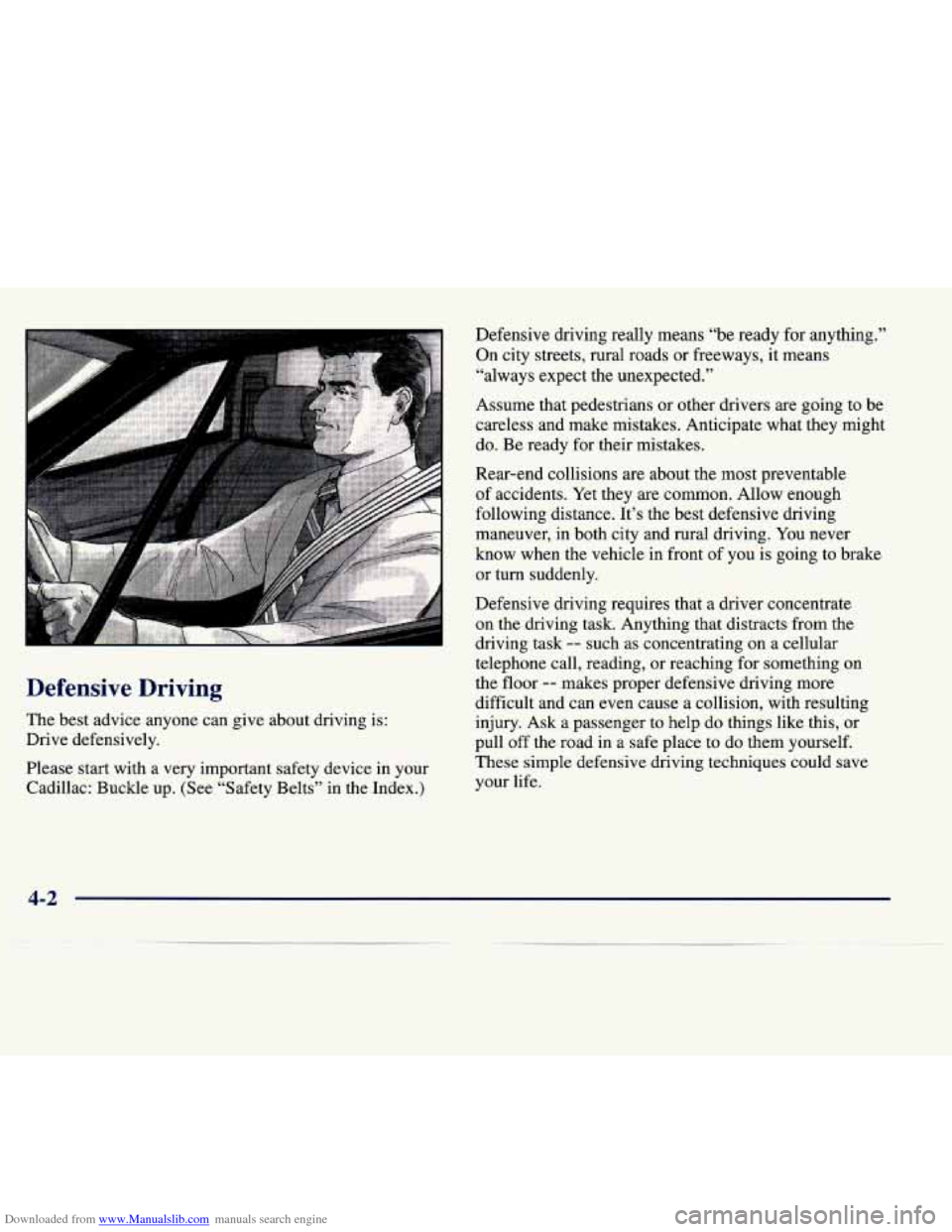
Downloaded from www.Manualslib.com manuals search engine Defensive Driving
The best advice anyone can give about driving is:
Drive defensively.
Please start with a very important safety device in your
Cadillac: Buckle up. (See “Safety Belts” in the Index.) Defensive driving really means “be ready
for anything.”
On city streets, rural roads or freeways, it means
“always expect the unexpected.”
Assume that pedestrians or other drivers are going to be
careless and make mistakes. Anticipate what they might
do. Be ready for their mistakes.
Rear-end collisions are about the most preventable
of accidents. Yet they are common. Allow enough
following distance. It’s the best defensive driving
maneuver, in both city and rural driving. You never
know when the vehicle in front of you
is going to brake
or turn suddenly.
Defensive driving requires that a driver concentrate
on the driving task. Anything that distracts from the
driving task
-- such as concentrating on a cellular
telephone call, reading, or reaching for something on
the floor
-- makes proper defensive driving more
difficult and can even cause a collision, with resulting
injury.
Ask a passenger to help do things like this, or
pull
off the road in a safe place to do them yourself.
These simple defensive driving techniques could save
your life.
4-2
Page 216 of 378
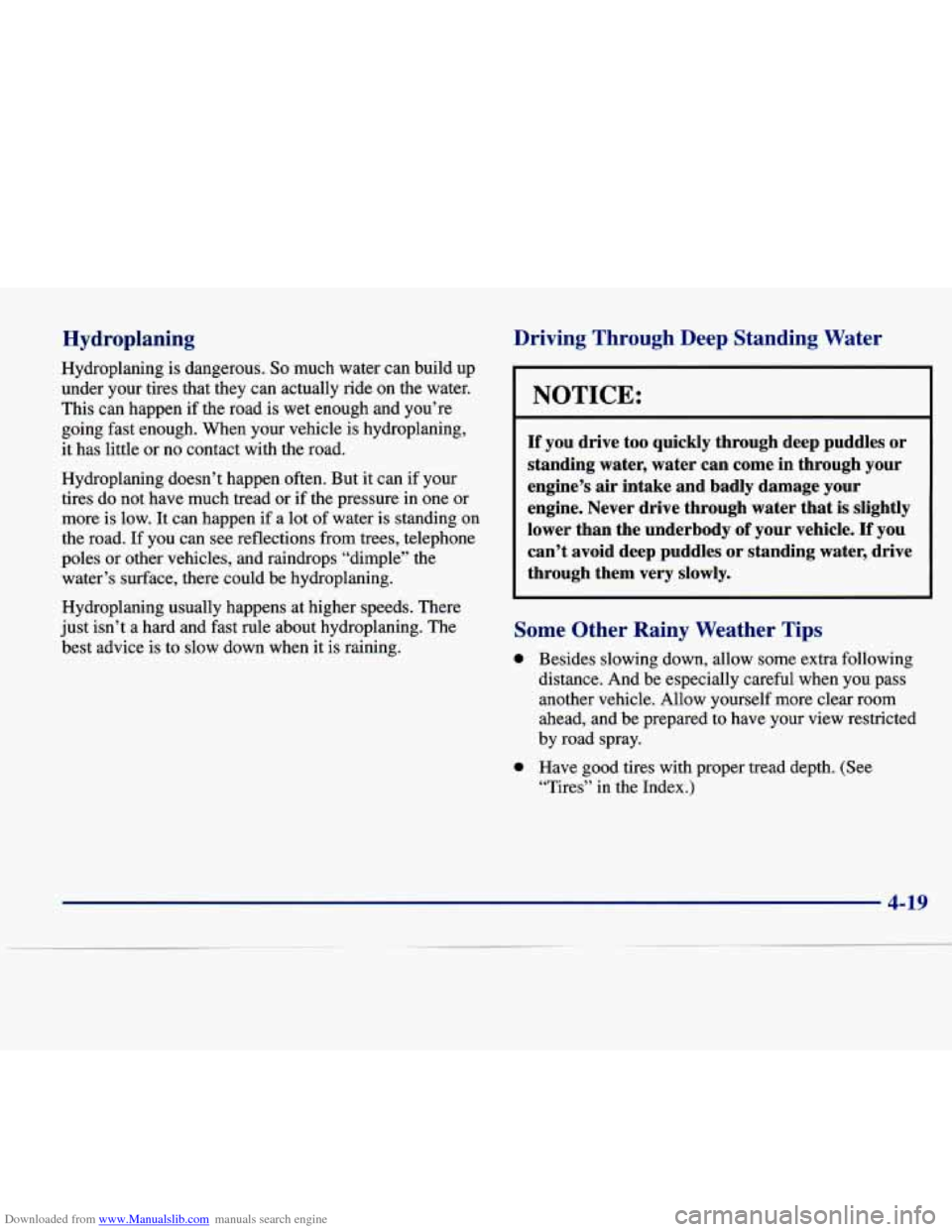
Downloaded from www.Manualslib.com manuals search engine Hydroplaning
Hydroplaning is dangerous. So much water can build up
under your tires that they can actually ride on the water.
This can happen
if the road is wet enough and you’re
going fast enough. When your vehicle is hydroplaning,
it has little or no contact with the road.
Hydroplaning doesn’t happen often. But it can if your
tires do not have much tread or if the pressure in one or
more is low. It can happen if a lot of water is standing on
the road. If you can see reflections from trees, telephone
poles or other vehicles, and raindrops “dimple” the
water’s surface, there could be hydroplaning.
Hydroplaning usually happens at higher speeds. There
just isn’t a hard and fast rule about hydroplaning. The
best advice is to slow down when it is raining.
Driving Through Deep Standing Water
NOTICE:
If you drive too quickly through deep puddles or
standing water, water can come in through your
engine’s air intake and badly damage your
engine. Never drive through water that is slightly
lower than the underbody
of your vehicle. If you
can’t avoid deep puddles or standing water, drive
through them very slowly.
Some Other Rainy Weather Tips
0
0
Besides slowing down, allow some extra following distance. And be especially careful when you pass
another vehicle. Allow yourself more clear room
ahead, and be prepared to have your view restricted
by road spray.
Have good tires with proper tread depth. (See “Tires” in the Index.)